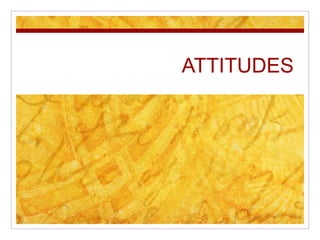
Q3L01 - Attitude: definition and components
- 1. ATTITUDES
- 3. … an association in memory between a given object and a given summary evaluation of the object” – Fazio, 1995 …a psychological tendency that is expressed by evaluating a particular entity with some degree of favour or disfavour” – Eagly & Chaiken, 1993 … a general and enduring positive or negative feeling about some person, object, or issue – Petty & Cacioppo, 1981 …the categorisation of a stimulus object along an evaluative dimension – Zanna & Rempel, 1988
- 4. … an association in memory between a given object and a given summary evaluation of the object” – Fazio, 1995 …a psychological tendency that is expressed by evaluating a particular entity with some degree of favour or disfavour” – Eagly & Chaiken, 1993 … a general and enduring positive or negative feeling about some person, object, or issue – Petty & Cacioppo, 1981 …the categorisation of a stimulus object along an evaluative dimension – Zanna & Rempel, 1988 4 out of 4 psychologists agree that attitude involves an evaluative judgment about someone or something.
- 5. Therefore… We define an attitude as… an overall evaluation of an object that is based on cognitive, affective, and behavioural information
- 6. …an overall evaluation of an object that is based on cognitive, affective, and behaviouralinformation Three distinct components: AFFECT, COGNITION, BEHAVIOUR Thinking Feeling Doing
- 7. Affective Component Attitudes can differ in valence (direction – positive/negative/neutral) POSITIVE – Best. Invention. Ever. NEUTRAL – Meh. NEGATIVE – Worst. Movie. Ever.
- 8. Affective Component (cont’d) Attitudes can vary in strength. Strong attitudes are more:a) Persistent over timeb) Resistant to changec) Likely to influence information processingd) Likely to predict behaviour
- 9. TASK Imagine that you have been given, as a graduation present, a choice between ten brand new cars. You have been told that this car will be the only car you will get to drive for the next twenty years, so you want to pick the car that is the most reliable. Which one of the following brands will you choose?
- 10. 3. Acura 1. Mercury 2. Scion 5. Lexus 4. Mitsubitshi 7. Infiniti 6. Hyundai 9. Honda 8. Toyota 10. Porsche
- 11. Based on surveys filled out by more than 1.4 million people, the following were deemed as the most reliable brands in the 2009 Consumer Reports Annual Car Reliability Survey in ascending order…
- 12. 10th – Mercury
- 13. 9th – Porsche
- 14. 8th - Hyundai
- 15. 7th - Lexus
- 16. 6th - Mitsubishi
- 17. 5th - Acura
- 18. 4th - Infiniti
- 19. 3rd – Toyota
- 20. 2nd - Honda
- 21. 1st - Scion
- 22. Cognitive Component Refers to the beliefs, thoughts and attributes we associate with an object. May be based primarily upon +ve and –ve attributes associated with the object. E.g. Belief #1. More expensive = better quality. Porsche/Lexus = $$$ = more reliable Belief #2. More popular = more people use it = more reliableNever heard of Scion, therefore probably unreliable.
- 23. Behavioural Component Refers to past behaviours or experiences regarding an attitude object. E.g. People might guess that they must have a negative attitude toward caged eggs if they remember having signed against unethical treatment of animals
- 24. What’s the difference? Is there one? Breckler (1984) had participants report their cognitive, affective and behavioural responses about snakes. With a real snake in the room, participants indicated whether:i) snakes are kind/cruel (cognition)ii) snakes make them feel anxious/happy (affect)iii) they like to handle snakes (behaviour) Scores for each response was computed, showing only moderate correlation. Does not mean they are completely independent of each other.
- 25. For example…
- 26. Betty’s Attitude towards Jason Mraz… Thoughts:The music has well-constructed lyrics and catchy melodies that express the importance Mraz places on the beauty and appreciation of life. Feelings:The music evokes happiness and relaxation. Behavioural:Attended six concerts
- 28. Therefore… The positive cognitions, affects and behaviours all contribute to Betty’s arguably unhealthy positive attitude toward Jason Mraz. BUT… Components do not always have the same evaluative implications…
- 29. For example… Blood donation Cognition: ……………………………….. Affect:……………………………………. Behaviour:………………………………...
- 30. Quick Task: 1) Think of something you have a positive/negative attitude towards that are similar in valence across the three components. Write down how each of the components influence this attitude. 2) Think of something you have a positive/negative attitude towards that differ in valence across the components. Write down how each of the components influence this attitude.
- 32. Functions Katz (1960) proposed that functions include:
- 33. 1) Knowledge The world is too complex… we group people, objects and events into categories and develop stereotyped attitudes. The attitudes about that category provide us with meaning, making inferences about its members.
- 34. 2) Instrumentality Means to an end We develop favourableattitudes towards objects that reward us and unfavourable attitudes towards punishment. Once developed, it provides a simple means of evaluating objects.
- 35. 3) Ego defence Some attitudes protect the person from recognising certain thoughts or feelings that threaten their self-image. E.g. displacing anger to other groups
- 36. 4) Value expressiveness Define the self and maintain self-worth. Some attitudes express the individual’s basic values and reinforce his or her self-image. Some attitudes symbolise a person’s identification with or membership in particular groups or subcultures.
- 37. IN SUM An attitude is an overall evaluation of an object that is based on cognitive, affective, and behaviouralinformation. The three components: cognition, affect, behaviour Affect can vary in valence and strength; Cognition influenced by +ve and –ve attributes associated with the object; behaviour is based on past experiences and actions. Functions of attitudes: knowledge, instrumentality, ego defence, value expressiveness.